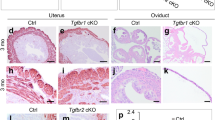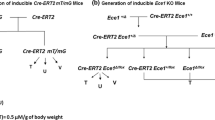Abstract
Conventional estrogen receptor α knockout (neo-ERαKO, neo-ERα−/−) mice contain a truncated and chimeric ERα fusion protein that retains 35% estrogen-dependent transactivation activity, and therefore the in vivo ERα function is difficult to study thoroughly. Furthermore, these neo-ERα−/− mice cannot be used for tissue and temporal specific ERα deletion. Therefore, there is a clear need to establish a floxed ERα mouse line that can knockout ERα specifically and completely in each selected cell type. Here we generated floxed ERα mice using a self-excising ACN (tACE-Cre/Neo) cassette. Mating the floxed ERα mice with ACTB-Cre mice produces a deletion of the floxed allele disrupting the reading frame of the ERα transcript so that no ERα protein is detected in the ACTB-Cre/ERα−/− mice. Expression of ERα target genes, such as G-6-PD and lactoferrin, is diminished by over 90% in the ACTB-Cre/ERα−/− uterus, but not in the neo-ERα−/− uterus. Furthermore, we also validated that ACTB-Cre/ERα−/− females have a hypoplastic internal genital tract, polycystic ovaries with hemorrhagic follicles, infertility, and higher body weight. Together, our data clearly demonstrate that the newly established floxed ERα mouse is a reliable mouse model for future studies of ERα roles in vivo in the selective estrogen target tissues. The complete knockout of ERα in the ACTB-Cre/ERα−/− mice will also provide an improved mouse model to study the role of ERα in vivo.




Similar content being viewed by others
References
Couse JF, Korach KS (1999) Estrogen receptor null mice: what have we learned and where will they lead us? Endocr Rev 20:358–417. doi:10.1210/er.20.3.358
Liu MM, Albanese C, Anderson CM, Hilty K, Webb P, Uht RM, Price RH Jr, Pestell RG, Kushner PJ (2002) Opposing action of estrogen receptors alpha and beta on cyclin D1 gene expression. J Biol Chem 277:24353–24360. doi:10.1074/jbc.M201829200
Kuiper GG, Enmark E, Pelto-Huikko M, Nilsson S, Gustafsson JA (1996) Cloning of a novel receptor expressed in rat prostate and ovary. Proc Natl Acad Sci USA 93:5925–5930. doi:10.1073/pnas.93.12.5925
Green S, Walter P, Kumar V, Krust A, Bornert JM, Argos P, Chambon P (1986) Human oestrogen receptor cDNA: sequence, expression and homology to v-erb-A. Nature 320:134–139. doi:10.1038/320134a0
Rosenfeld MG, Glass CK (2001) Coregulator codes of transcriptional regulation by nuclear receptors. J Biol Chem 276:36865–36868. doi:10.1074/jbc.R100041200
Paech K, Webb P, Kuiper GG, Nilsson S, Gustafsson J, Kushner PJ, Scanlan TS (1997) Differential ligand activation of estrogen receptors ERalpha and ERbeta at AP1 sites. Science 277:1508–1510. doi:10.1126/science.277.5331.1508
Pace P, Taylor J, Suntharalingam S, Coombes RC, Ali S (1997) Human estrogen receptor beta binds DNA in a manner similar to and dimerizes with estrogen receptor alpha. J Biol Chem 272:25832–25838. doi:10.1074/jbc.272.41.25832
Dupont S, Krust A, Gansmuller A, Dierich A, Chambon P, Mark M (2000) Effect of single and compound knockouts of estrogen receptors alpha (ERalpha) and beta (ERbeta) on mouse reproductive phenotypes. Development 127:4277–4291
Kushner PJ, Agard DA, Greene GL, Scanlan TS, Shiau AK, Uht RM, Webb P (2000) Estrogen receptor pathways to AP-1. J Steroid Biochem Mol Biol 74:311–317. doi:10.1016/S0960-0760(00)00108-4
Lazennec G, Bresson D, Lucas A, Chauveau C, Vignon F (2001) ER beta inhibits proliferation and invasion of breast cancer cells. Endocrinology 142:4120–4130. doi:10.1210/en.142.9.4120
Lubahn DB, Moyer JS, Golding TS, Couse JF, Korach KS, Smithies O (1993) Alteration of reproductive function but not prenatal sexual development after insertional disruption of the mouse estrogen receptor gene. Proc Natl Acad Sci USA 90:11162–11166. doi:10.1073/pnas.90.23.11162
Couse JF, Curtis SW, Washburn TF, Lindzey J, Golding TS, Lubahn DB, Smithies O, Korach KS (1995) Analysis of transcription and estrogen insensitivity in the female mouse after targeted disruption of the estrogen receptor gene. Mol Endocrinol 9:1441–1454. doi:10.1210/me.9.11.1441
Feng Y, Manka D, Wagner KU, Khan SA (2007) Estrogen receptor-alpha expression in the mammary epithelium is required for ductal and alveolar morphogenesis in mice. Proc Natl Acad Sci USA 104:14718–14723. doi:10.1073/pnas.0706933104
Yeh S, Tsai MY, Xu Q, Mu XM, Lardy H, Huang KE, Lin H, Yeh SD, Altuwaijri S, Zhou X, Xing L, Boyce BF, Hung MC, Zhang S, Gan L, Chang C (2002) Generation and characterization of androgen receptor knockout (ARKO) mice: an in vivo model for the study of androgen functions in selective tissues. Proc Natl Acad Sci USA 99:13498–13503. doi:10.1073/pnas.212474399
Maclean HE, Chiu WM, Ma C, McManus JF, Davey RA, Cameron R, Notini AJ, Zajac JD (2008) A floxed allele of the androgen receptor gene causes hyperandrogenization in male mice. Physiol Genomics 33(1):133–137
Lakso M, Sauer B, Mosinger B Jr, Lee EJ, Manning RW, Yu SH, Mulder KL, Westphal H (1992) Targeted oncogene activation by site-specific recombination in transgenic mice. Proc Natl Acad Sci USA 89:6232–6236. doi:10.1073/pnas.89.14.6232
Bunting M, Bernstein KE, Greer JM, Capecchi MR, Thomas KR (1999) Targeting genes for self-excision in the germ line. Genes Dev 13:1524–1528. doi:10.1101/gad.13.12.1524
Zhang M, Altuwaijri S, Yeh S (2004) RRR-alpha-tocopheryl succinate inhibits human prostate cancer cell invasiveness. Oncogene 23:3080–3088. doi:10.1038/sj.onc.1207435
Yin Y, Ni J, Chen M, DiMaggio MA, Guo Y, Yeh S (2007) The therapeutic and preventive effect of RRR-alpha-vitamin E succinate on prostate cancer via induction of insulin-like growth factor binding protein-3. Clin Cancer Res 13:2271–2280. doi:10.1158/1078-0432.CCR-06-1217
Ni J, Wen X, Yao J, Chang HC, Yin Y, Zhang M, Xie S, Chen M, Simons B, Chang P, di Sant’Agnese A, Messing EM, Yeh S (2005) Tocopherol-associated protein suppresses prostate cancer cell growth by inhibition of the phosphoinositide 3-kinase pathway. Cancer Res 65:9807–9816. doi:10.1158/0008-5472.CAN-05-1334
Colledge WH, Abella BS, Southern KW, Ratcliff R, Jiang C, Cheng SH, MacVinish LJ, Anderson JR, Cuthbert AW, Evans MJ (1995) Generation and characterization of a delta F508 cystic fibrosis mouse model. Nat Genet 10:445–452. doi:10.1038/ng0895-445
Olson EN, Arnold HH, Rigby PW, Wold BJ (1996) Know your neighbors: three phenotypes in null mutants of the myogenic bHLH gene MRF4. Cell 85:1–4. doi:10.1016/S0092-8674(00)81073-9
Meyers EN, Lewandoski M, Martin GR (1998) An Fgf8 mutant allelic series generated by Cre- and Flp-mediated recombination. Nat Genet 18:136–141. doi:10.1038/ng0298-136
Kos M, Denger S, Reid G, Korach KS, Gannon F (2002) Down but not out? A novel protein isoform of the estrogen receptor alpha is expressed in the estrogen receptor alpha knockout mouse. J Mol Endocrinol 29:281–286. doi:10.1677/jme.0.0290281
Isken O, Maquat LE (2007) Quality control of eukaryotic mRNA: safeguarding cells from abnormal mRNA function. Genes Dev 21:1833–1856. doi:10.1101/gad.1566807
Flouriot G, Brand H, Denger S, Metivier R, Kos M, Reid G, Sonntag-Buck V, Gannon F (2000) Identification of a new isoform of the human estrogen receptor-alpha (hER-alpha) that is encoded by distinct transcripts and that is able to repress hER-alpha activation function 1. EMBO J 19:4688–4700. doi:10.1093/emboj/19.17.4688
Barraille P, Chinestra P, Bayard F, Faye JC (1999) Alternative initiation of translation accounts for a 67/45 kDa dimorphism of the human estrogen receptor ERalpha. Biochem Biophys Res Commun 257:84–88. doi:10.1006/bbrc.1999.0334
Kos M, O’Brien S, Flouriot G, Gannon F (2000) Tissue-specific expression of multiple mRNA variants of the mouse estrogen receptor alpha gene. FEBS Lett 477:15–20. doi:10.1016/S0014-5793(00)01750-6
Schomberg DW, Couse JF, Mukherjee A, Lubahn DB, Sar M, Mayo KE, Korach KS (1999) Targeted disruption of the estrogen receptor-alpha gene in female mice: characterization of ovarian responses and phenotype in the adult. Endocrinology 140:2733–2744. doi:10.1210/en.140.6.2733
Wade GN, Gray JM, Bartness TJ (1985) Gonadal influences on adiposity. Int J Obes 9(Suppl 1):83–92
Heine PA, Taylor JA, Iwamoto GA, Lubahn DB, Cooke PS (2000) Increased adipose tissue in male and female estrogen receptor-alpha knockout mice. Proc Natl Acad Sci USA 97:12729–12734. doi:10.1073/pnas.97.23.12729
Acknowledgments
This work was partly supported by NIH grant DK60912. This research was also supported in part by NICHD/NIH through cooperative agreement (U54 HD 933067, the Baltimore-Chicago Center for Reproductive Research) as part of the Specialized Cooperative Centers Program in Reproduction and Infertility Research (SCCPIR). The technical assistance of Yayoi Shibusawa is gratefully acknowledged. We also thank Karen Wolf and Susan R. Schoen for assisting in manuscript preparation.
Author information
Authors and Affiliations
Corresponding authors
Additional information
M. Chen and A. Wolfe contributed equally to this article.
Rights and permissions
About this article
Cite this article
Chen, M., Wolfe, A., Wang, X. et al. Generation and characterization of a complete null estrogen receptor α mouse using Cre/LoxP technology. Mol Cell Biochem 321, 145–153 (2009). https://doi.org/10.1007/s11010-008-9928-9
Received:
Accepted:
Published:
Issue Date:
DOI: https://doi.org/10.1007/s11010-008-9928-9




